If you need information about spiders, their internal and external structure, as well as how they build nests, multiply, then read the article.
Contents
- What is the name of the science studying spiders?
- Which class belongs to spiders?
- How many spiders have legs, limbs?
- The external structure of the body of spiders: a diagram of a spider-cross with inscriptions and description
- The internal structure of the body of the spider: the scheme of the spider of the cross with the inscriptions and the description
- How many eyes do spiders have?
- The structure of the eye of a spider-cross: a diagram with inscriptions and description
- The structure of the circulatory system and breathing of spiders: Scheme
- Features of the vital activity and nutrition of the spider - on the example of the crossman: what are the features of behavior?
- Spider sensory organs: Features
- How a spider weaves a web: Composition
- Spider web structure: Description
- Features of the propagation of spiders: Description
- What spider builds underwater nests?
- How does the Serebryan spider fill its nest?
- How many spiders live?
- Buh of a spider-cross: Is it dangerous for a person?
- Video: Arachnid class. Video lesson in biology grade 7
Spiders-who is it, insects, animals or someone else? This question is often asked by many people. At the school in zoology lessons, students make presentations about them and write messages and works. Below you will find information about spiders, and answers to all your questions.
What is the name of the science studying spiders?

Read the other article about spiders that tells this insects or animals, as well as about what dangerous spiders exist in nature.
Science studying spiders is called arachnology. She is divided into:
- Aranology (about spider -shaped animals)
- Acarology (about ticks)
There are also a number of sciences about other arachnids, including scorpions, phalanxes and other species. The name comes from the ancient Greek myth of the Lydian spas Arachne, which was turned into a spider of the goddess Athena.
Arachnology is divided into:
- Veterinary
- Medical
- Agricultural
- Forest
Those ailments that can arise in a person due to the bite of spiders are called arachnoses. Research works in the field of this science take place at the Zoological Institute of the Russian Academy of Sciences, as well as at the departments of zoology of various universities.
Which class belongs to spiders?
For a long time there were disputes regarding what class the spider belongs to and whether it is an insect. In fact, with butterflies and beetles, spiders have nothing to do. They belong to the class of arthropods, the type of spider -shaped. They also consist in the arthropod class that breathe with the help of a trachea - this is a separate subtype.
There are a total of 43,000 spiders, among which 1100 fossils. As a rule, these are bonding predators. Spiders are classified by the type of digestion.
How many spiders have legs, limbs?

The limbs of the spiders are located directly on the header. The number of legs can be easily counted - on average, 8 pieces. As a rule, this figure coincides in all types and is in no way connected with the age of the individual, the environment and its size.
The legs of the spider not only allow him to move quickly, but also hold and endure cocoons, like hands. There are small processes on the abdomen.
It is worth knowing: You can not call the paws all the limbs of the spider. Ahead are a nail -reader. They are needed for orientation around themselves. As a rule, before going somewhere, the spider “probes” the path and receives signals regarding the safety and nuances of movement by location.
Another type of spider -shaped limbs are nail sole. They are used in order to protect themselves in case of danger.
- Joints at the spider 48 - 6 on each leg.
- Spiders can not only catch up with insects, but also determine how edible they are.
The spider is quite vague - catching the vibration from the victim with the help of thin legs, it is able to move very quickly and instantly overtake it. Also, these arthropods know how to jump - as a rule, to a height 50 times more size of your own body. You can find spiders that do not have enough 1-2 legs.
The external structure of the body of spiders: a diagram of a spider-cross with inscriptions and description

The spider-cross has such a name thanks to the drawing on its back, which really resembles a cross. The external structure of the body of spiders:
- The drawing on the body of the top is made up of light spots.
- Different individuals may have different colors.
- Females are larger than males. Female individuals of this species have a large, round body, and male - narrow and small.
- The body of the spider - the crossman is covered with a chitin cover, which is replaced during molting.
The main components of the body:
- Golovoad
- Abdomen
They are connected by a plug. The organs of vision are located on the header. Despite the fact that spiders have several pairs of eyes, they see badly. Therefore, the touch organs often come to the rescue.
- Nogging are limbs that belong to the rotary apparatus. Clawers at their ends have toxic ducts. This is necessary to kill prey and defense from the attack.
- Nogan -readers Need for touch.
- Golovoad It has 8 legs for walking - on each side of 4 pieces. The spider has three types of claws. There are crests with which he weaves a web, there are the rest with which he moves. The lower part of the abdomen has an anal and sexual hole, as well as respiratory organs.
The spider also has web warts. As a rule, these are three small tubercles, on the top of which special ducts. Here is a diagram of a spider-cross and a spider of another type with inscriptions and description of the parts of the body:
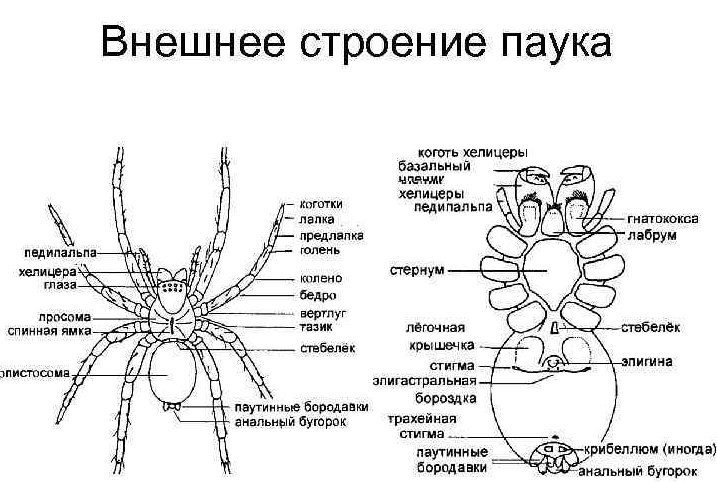
The internal structure of the body of the spider: the scheme of the spider of the cross with the inscriptions and the description
In its inner structure, the spider is similar to cancer. But there are differences - in the circulatory and digestive systems. The internal structure of the body of the spider:
- The internal organs of the spider are in the abdomen. Due to the features of digestion, hard food for the spider is not available.
- The assimilation of food begins outsideWhen the individual injects enzymes and poison with the help of Heliczer. It follows intestinal and intracellular digestion. The spider also has a mouth, throat, esophagus, intestines, sucking stomach, liver.
- Respiratory system represented by trachea. As for the pulmonary bags, they are located in the abdominal cavity, in its front part. There are air and folds - platinum.
- Instead of blood in hemolymph spidersenriched with oxygen. She is blue.
- Trachea Spider is needed in order to direct oxygen to the organs. Both light and trachea have breathing holes.
- The blood system, blood vessels belong to the blood system.
- Front and back aortics - The largest. Hemolymphs enters the heart through the ostia, and from there moves along aortics and small arteries, flowing into the body and washing all the internal organs, supplying them with oxygen and nutrients.
- Pair of Malpigians vessels serve as the discharge, leaving the abdominal cavity with a blind end. Metabolism products are absorbed precisely through their walls.
- Anal hole The spider releases Guanin crystals along with the remnants of undigested food.
- Output flows At the base of each leg are presented in the form of coksal glands, peculiar channels.
- To a nervous spider system The nervous chain of the abdominal cavity, nerves and nodes, the brain belong. As a rule, it is connected to the eyes with the help of nerves, also associated with all limbs and organs.
Here is a diagram of the internal organs of the spider with inscriptions and description:
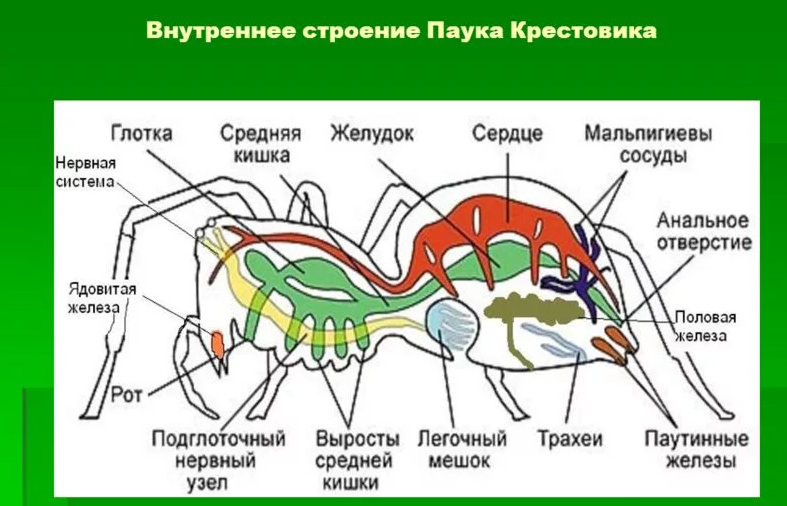
How many eyes do spiders have?
The visual system of spiders is the result of a long evolutionary development. Depending on the lifestyle and the way of hunting a spider -shaped, the number of eyes may vary, but usually this 4 pairs. They are represented by rows.
- 8 eyes The spider provides an excellent review.
- However, in nature there are also species that have 12 eyes.
- Some have only 2 eyes.
At the Cross 8 eyes. He hunts, as a rule, at night. The vision of this spider has polarized radiation.
Spider-slide It has 8 eyesthat are located in three rows. It determines the exact distance to the subject thanks to the main eyes that have 4 sensitive regime.
The structure of the eye of a spider-cross: a diagram with inscriptions and description
The organs of the spider are able to work differently.
- The middle pair is much larger than the "additional" eyes.
- The organs of the spider do not have a mirror to reflect sunlight. However, they can move, thanks to the attached muscles.
- Side eyes, on the contrary, have a mirror that can be removed, but do not have muscle beams.
Vision at the crossman leaves much to be desired. The spider does not see the details of the world well - it is either outlines, light or shadow. However, its sensitivity, which is provided by special hairs, allows you to perfectly navigate in habitats.
Each type of spiders has its own functions - some catch sounds, others perceive air vibrations, others react to chemical stimuli. The eyes of the crossman consist of retina, muscles and lens. Here is the structure of the eye of a spider-cross in the form of a scheme with inscriptions and description:

The structure of the circulatory system and breathing of spiders: Scheme
Circulatory system In thesons, it is closely related to the type of breathing, body size and other factors:
- The heart is developed in large individuals.
- The breath is tracheal.
- Spiders have 3-4 pairs Osty.
- Blood rushes to heart from all cavities between organs.
- There are several types of cells in the blood of spiders.
- The spiders have hemolymphs, which supplies organs with oxygen.
- The circulatory system of spiders is expressed by the front and rear aorta.
- Ostia is needed in order for hemolymphs to fall into the heart and carry out further movement.
Respiratory system:
- Spiders have lungs that are reduced by trachea.
- The pulmonary bag has leaf -shaped pockets in which blood circulates.
- Air also penetrates them.
- The trachea are represented by unstable tubes.
Here is a structure in the form of a scheme:
- Circulatory system
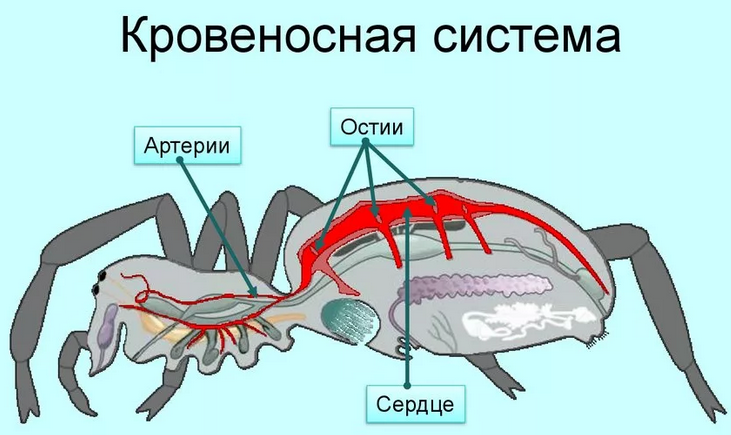
- Respiratory system

Features of the vital activity and nutrition of the spider - on the example of the crossman: what are the features of behavior?
The crossman lives where there is enough liquid. He has his web between the branches, finding shelter in small shrubs or among the foliage of trees. That is why spiders live well in forests, gardens and parks.
Here features of the vital activity and nutrition of the spider On the example of the cross:
- You can find a web of crosses in abandoned buildings - as a rule, these are attics, doorways, window frames and other secluded places.
- The glands that produce “material” for the network are located on the abdomen. The connection that stands out with spiders is close to soft silk.
- Crosses prefer to conduct "weaving" work in the dark. As a rule, enemies at such a time sleep and do not interfere.
- Crosses are individualists. They do not need constant communication with relatives. Spiders may well be single.
- It happens that individuals are hiding. But sometimes they proudly sit in the middle of their web, without fear of anyone.
- Most often, mosquitoes, flies, and other small insects fall into the trap. Makes the prey instantly.
Spiders are carnivorous. They can also eat various viles and many types of small insects. But to hide the food in the web “for later”, if not hungry, also in their manner of behavior. Read more:
- The appetite of the crosses are good.
- During the day they eat as much as they weigh themselves. It’s even scary to imagine a similar record in a person.
- Also, spiders are able to guard the victim without sleep and rest.
- Crosses digest food are also interesting. They begin outside, letting the digestive juice into the body of their victim. After that, the spider turns prey into a substance ready for use - calmly eats.
Spider is a christmasman cunning. Here are its features of behavior:
- If his network comes across prey, which he cannot “master”, then he gets rid of the victim, cutting off the web so that it can run away.
- However, if the enemy is trying to attack, the spider uses Helusers. In a similar way, he can even neutralize, for example, a frog.
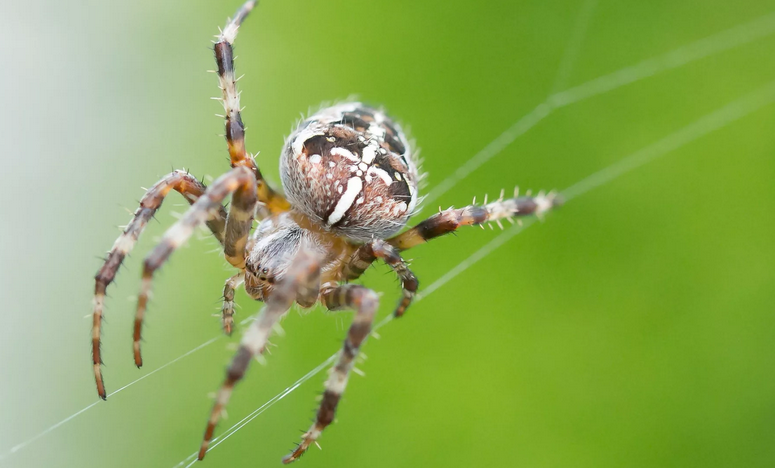
"Personal life" of the cross It also occurs on the web:
- At first, he finds his partner and attaches his thread on her web (usually in the lower edge).
- The female instantly feels this signal.
- Then she goes down to the male, responding to his signs of attention.
- After mating, male individuals do not survive.
- The female creates a cocoon and lays eggs.
Nest:
- At first, the “newly -minted mother” drags a house for offspring on his shoulders.
- Then he finds a permanent place of residence.
- The cubs remain in the house for the winter without going out.
- They are destined to leave the cocoon only in the spring.
- The mother herself does not live until warm days.
- Young spiders grow, passing through the entire warm period, and after the propagation cycle is repeated. But already other individuals.
The lifespan of the crosses: less than a year (taking into account wintering).
Spider sensory organs: Features

A key role for spiders is played by touch. They have trichobrians - these are hairs located throughout the body. Each of them is attached to the cover. There is also a hole with sensitive cells. This is the place of connection. Here are the features of the spider sensory organs:
- Mechanical movement It is determined due to the fluctuations of trichobotria.
- Spiders are able to catchHow their web swaying, or how the wind blows, they distinguish between sounds and their nature.
- For chemical feelings The lyre -shaped organs answer, which are located in spiders throughout the body. As a rule, these are cracks with sensitive cells. They replace the smell organs.
- Spider -shaped can distinguish the tasteThanks to the cells in walking legs, as well as the nails and the side of their pharynx.
However, the smells from afar do not feel spiders - only those that are closely.
How a spider weaves a web: Composition
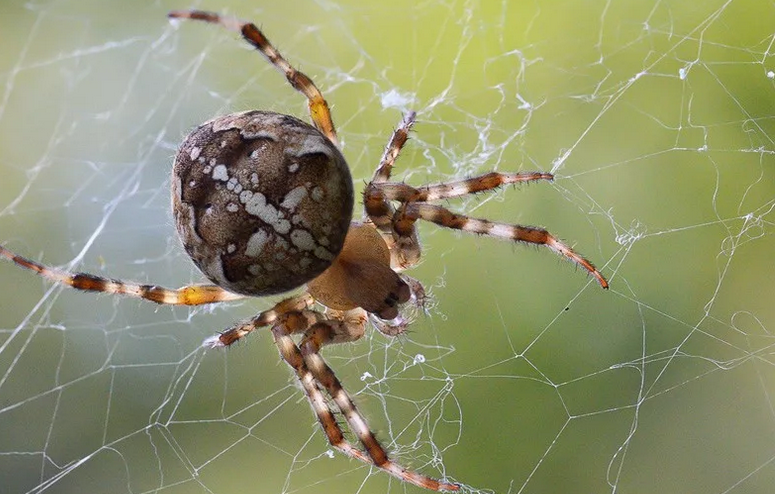
“Weaving craft” in spiders is inherited. They can build canvases, nets in the form of funnels, as well as cocoons for their larvae. In other words, each child repeats the actions of the mother, and does this instinctively, at the level of the subconscious. Of course, the web is different in shape, structure and size.
It is worth knowing: A web is a secret that is stretched after discharge and hardens. As the threads are intertwined, the “traps” are becoming stronger.
Each spider has special warts on the abdomen. A viscous fluid from the ducts acts on them, which subsequently turns into thin fibers.
The web that weaves the spider includes:
- Glycine
- Alanin
- Serin
It also has a high concentration of protein. As a rule, the threads are very durable, elastic. They can rotate, but not twist.
Spider web structure: Description
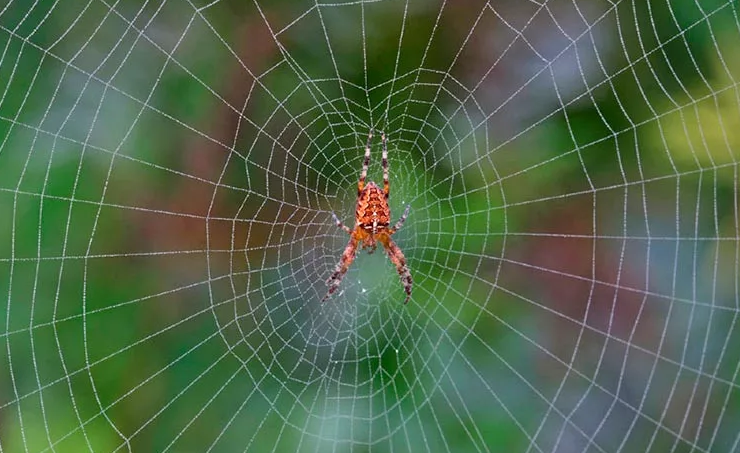
In order for the capture of the victim to be reliable, the spiders weave complex constructions. Each pattern in this case can be unique. Most often, networks with many angles are made. Round web patterns are also possible.
Interesting: Spiders are very patient creatures. Therefore, sitting on the upper branch, they can thoroughly form a thread for a long time. As a rule, the thread clings to the branch in a suitable place, and the “weaver” itself moves and begins to work in a new location.
If the thread does not manage to hook, the spider eats it, and begins the process again. Here is a description of the structure of the spider web:
- First, the frame is formed. After the connecting threads between the radii of the structure are performed. However, this is a classic approach. It all depends on the type of spiders.
- Verons make a semblance of funnels and hide. When the prey is approaching, the spider leaves the shelter and delays the victim in captivity.
- There are spiders whose threads are zigzag. It is very difficult to get out of them. But the spider "pain" weaves only 1 thread With a drop of glue. He shoots the sacrifice, and she sticks tightly.
The web are different and their structure depends on the type of spider.
Features of the propagation of spiders: Description
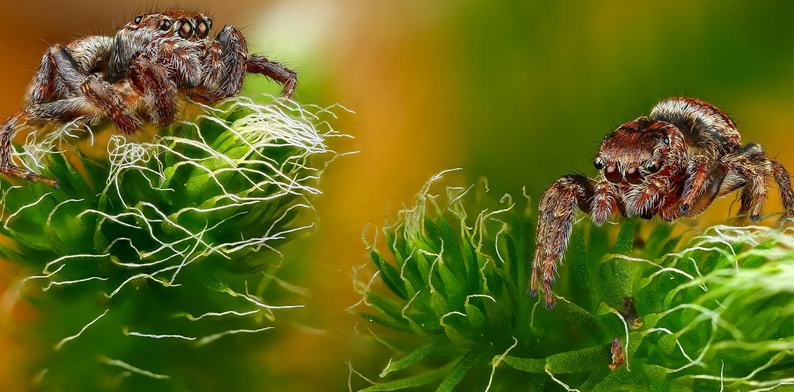
Like all separate individuals, the reproduction of spiders entails the appearance of offspring. Here is a description of the features of the propagation of spiders:
- As mentioned above, the male shows the initiative, gradually penetrating the territory of the female and giving her signals to mating.
- After the intercourse is completed, the male, as a rule, does not survive.
- And the female goes to lay eggs.
The season of love lasts from mid -autumn to winter. At the ends of Pedipalp, the spider has bulbs that he fills with sperm, before going in search of a “lover”.
The eggs of the female are laid through 2.5 months After intercourse. Kids are born through 35 days. In the web, they are destined to live before the first molting.
What spider builds underwater nests?
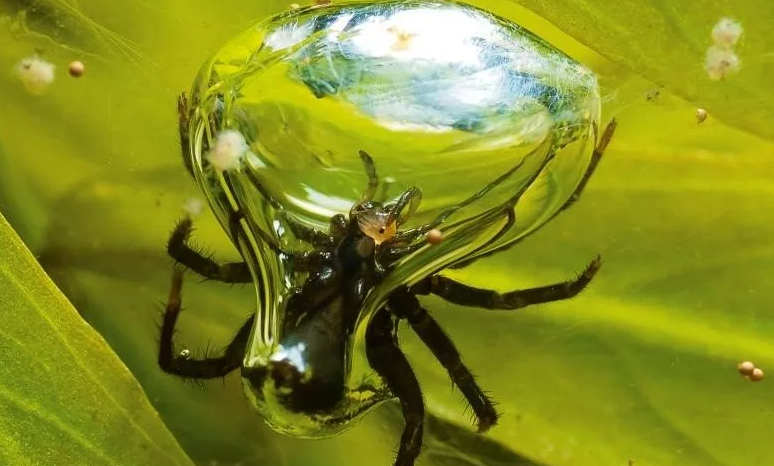
Underwater nests are building a steroga spider. It is very common in the Russian Federation, exists under water. As a rule, the spider creates several domes - these are nests filled with oxygen.
- Serebryanka domes are summer.
- They can also be intended for shelter, mating or eating.
Also, the Spider does a separate nest for gathering sperm, laying eggs and there is a “room” for molting.
How does the Serebryan spider fill its nest?
Serebryanka fills its nest by air bubbles. It is a semblance of a dome, and as mentioned above, each is used for specific purposes.
How many spiders live?
The life expectancy of spiders depends on both view and size. Suppose the smallest, harmless spiders live from 10 months up to a year. Females always live longer than males.
- On average, the male floor lives for no more than three months, and the female floor - about six months.
- At home, a spider, devoid of the dangers of the external environment, can live a year. But this is provided that he has no enemies and good conditions of detention.
But in nature there are spiders that have existed for a very long time:
- Spiders-pedicels live up to 30 years.
- Tarantula - approximately 15 years
- Goliath - no more than 10 years
- The life of a black widow is approximately 5 years.
As you can see, the lifetime of different spiders is different.
Buh of a spider-cross: Is it dangerous for a person?
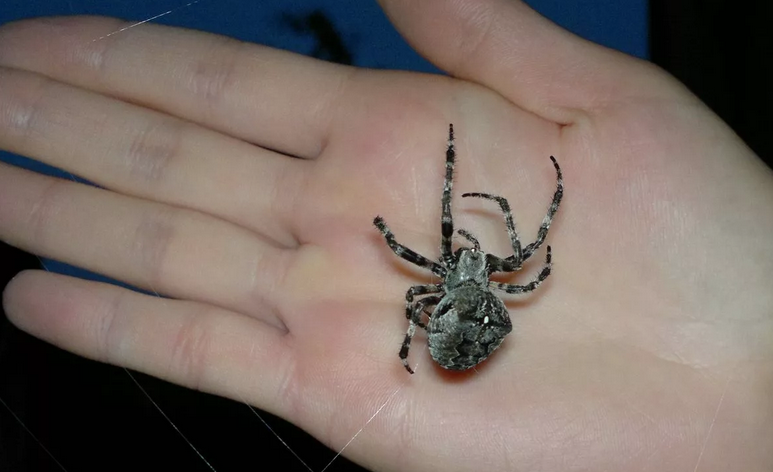
Many people mistakenly believe that the crossman is dangerous for a person. It is a myth.
- The poison of a spider with a cross is very dangerous for rodents and other small animals - for a person it is not deadly.
However, if the house has pets in the form of mice, rats and animals like them, then it is better to protect them from the spider-cross.
Video: Arachnid class. Video lesson in biology grade 7
Read on the topic:







